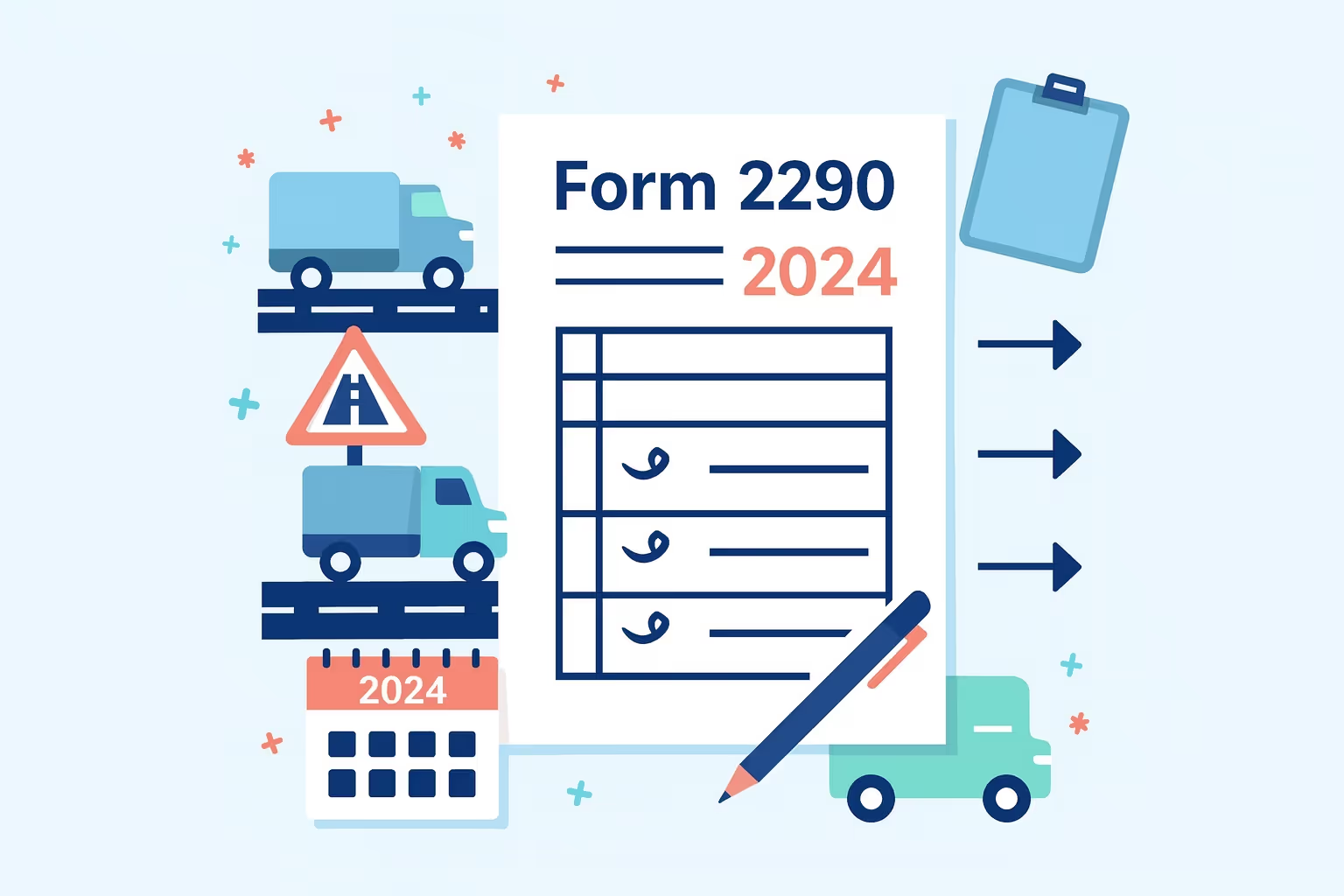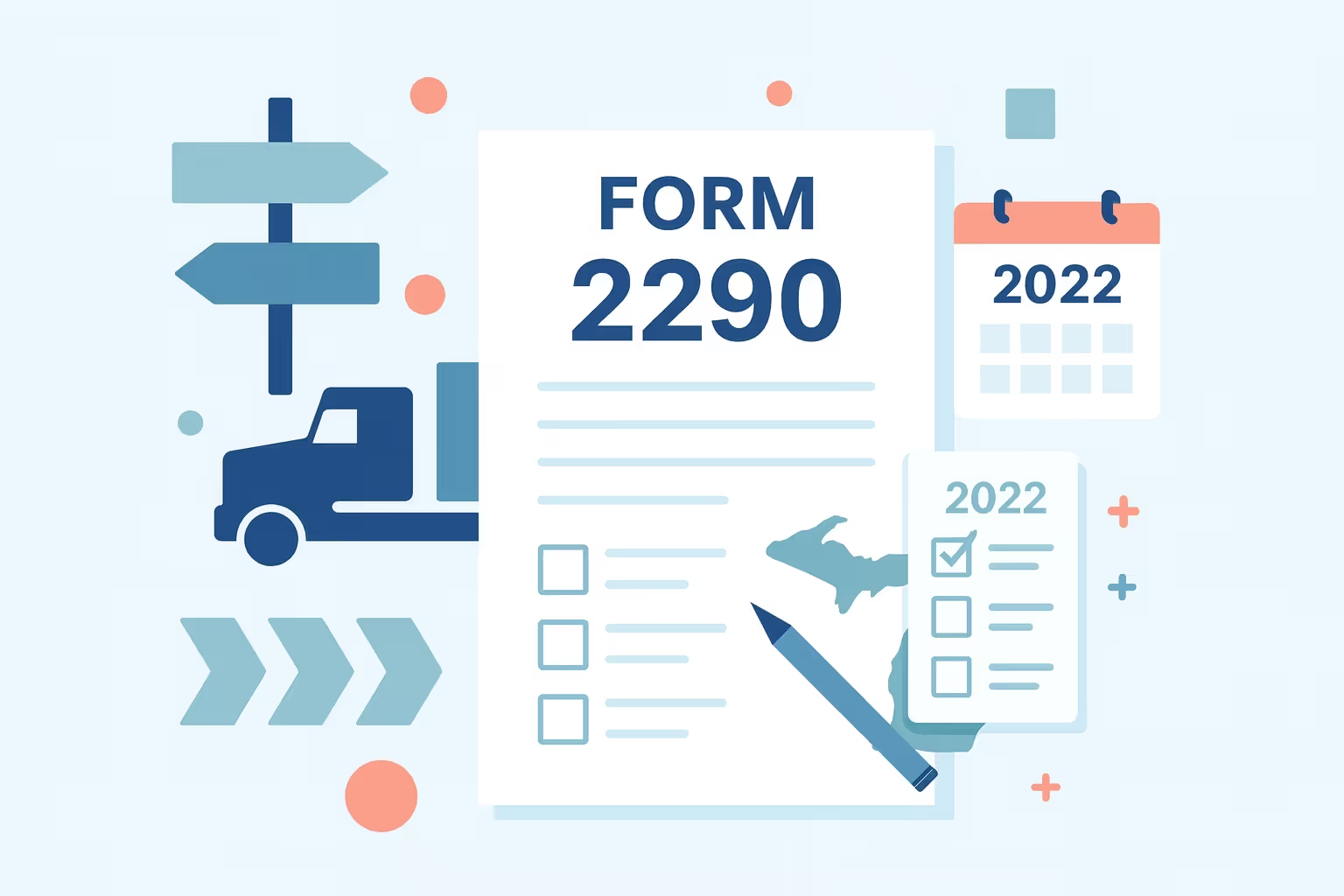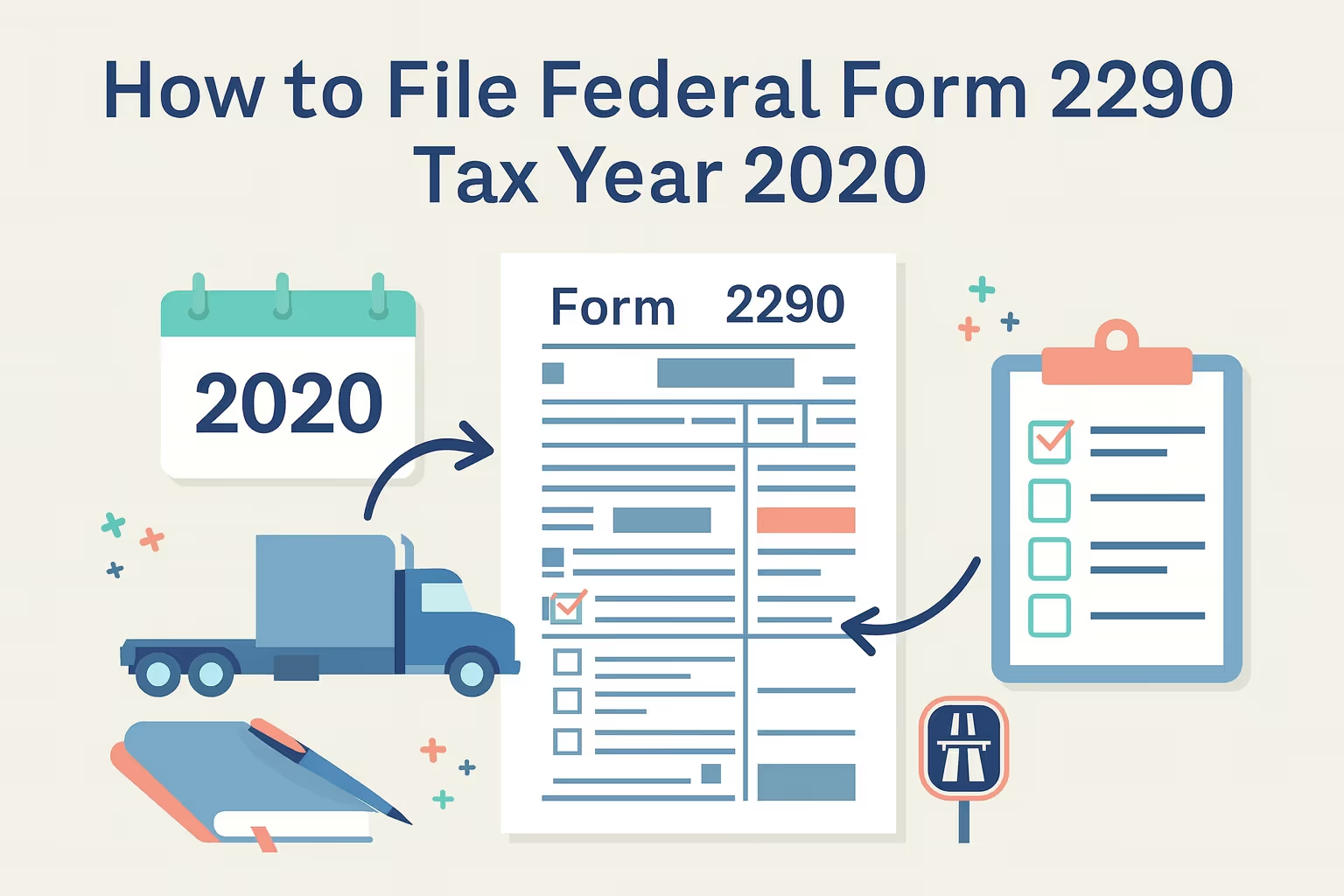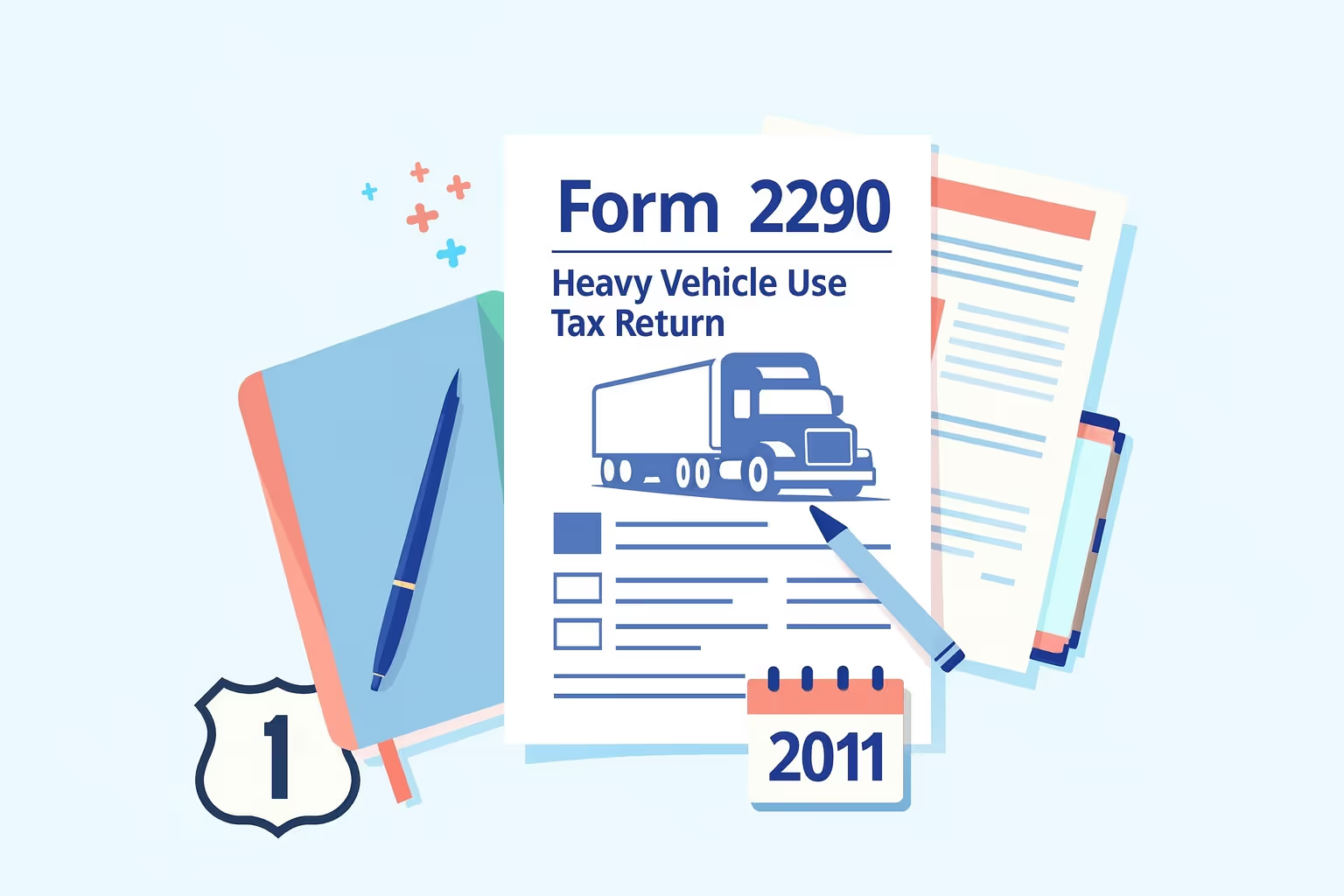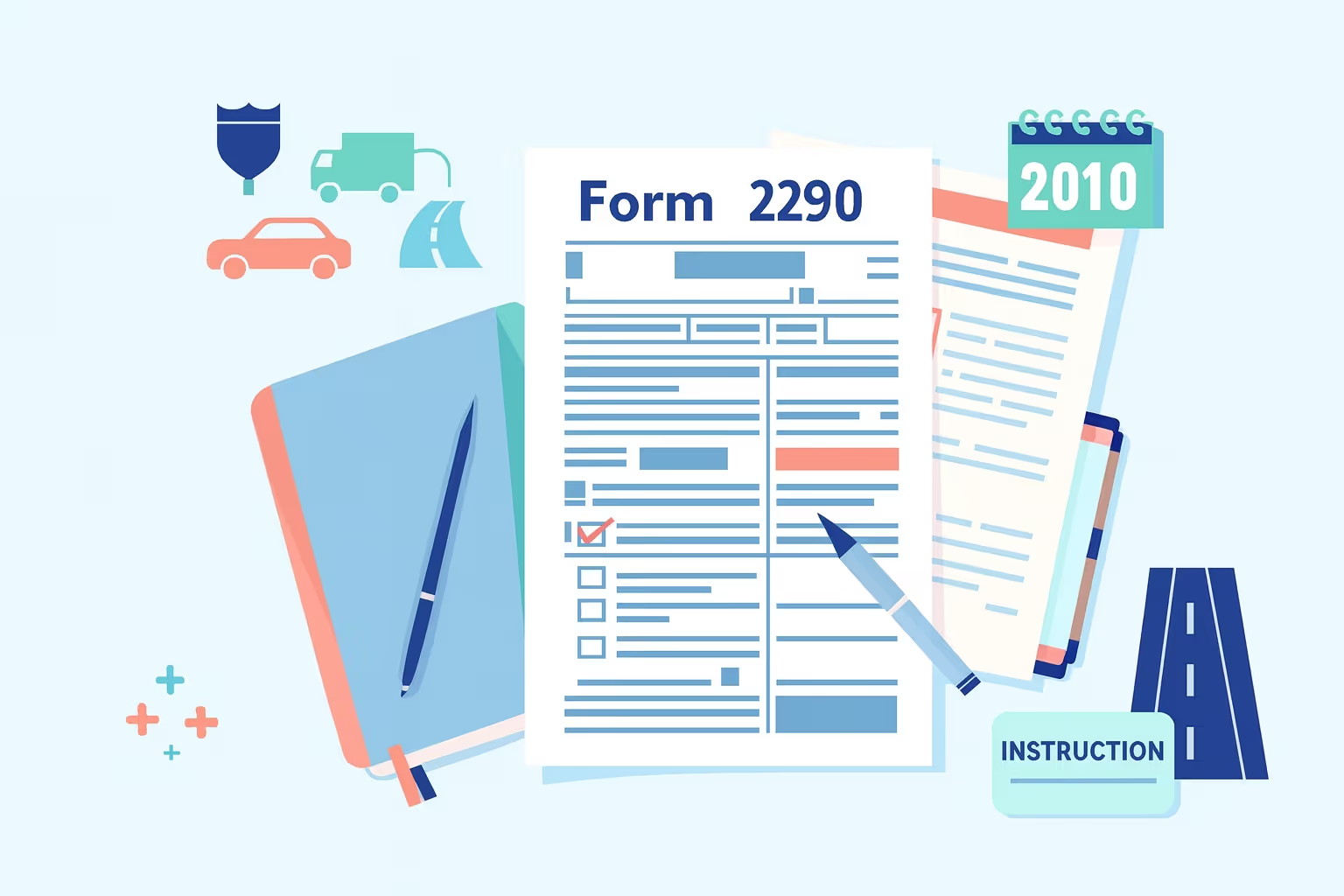Form 2290 2014 Instructions: Filing Guide for Heavy Vehicles
Filing IRS Form 2290 is a federal requirement for owners and operators of highway motor vehicles with a taxable gross weight of 55,000 pounds or more. This form reports and pays the Heavy Highway Vehicle Use Tax for motor vehicles operating on public highways during the 2014 tax period, which runs from July 1, 2014, through June 30, 2015. Understanding how to file Form 2290 helps you complete your Heavy Highway Vehicle Use Tax return accurately and comply with IRS reporting requirements.
The Heavy Highway Vehicle Use Tax funds essential infrastructure by collecting an annual fee from owners of qualifying vehicles. Each filer must determine if a vehicle is taxable, suspended, or exempt based on its mileage and operational use. Correct reporting allows the IRS and Department of Motor Vehicles (DMV) to verify payment and authorize vehicle registration. For suspended or exempt vehicles, accurate documentation prevents processing delays and supports future claims.
According to the IRS, taxpayers can access the official "About Form 2290, Heavy Highway Vehicle Use Tax Return" page to review filing rules, vehicle categories, and annual updates. Following these guidelines helps you accurately record payments, claim credits for sold or destroyed vehicles, and provide proof of compliance when registering with your state's DMV.
Filing Requirements and Due Dates for the 2014 Tax Year
Owners and operators of highway motor vehicles must understand the specific filing timeline and method for IRS Form 2290 for the 2014 tax year. Filing requirements apply to taxable motor vehicles with a gross weight of 55,000 pounds or more that operate on public highways. Each filer is responsible for submitting a timely tax return and ensuring the information aligns with their Department of Motor Vehicles (DMV) registration records.
Who Must File
- Individuals or businesses that operate taxable vehicles registered under U.S., Canadian, or Mexican jurisdictions must file Form 2290.
- Owners of vehicles used on public highways during the 2014 period, including those leased or jointly owned, are required to file a return.
- Filers with vehicles exceeding the 5,000-mile limit (7,500 miles for agricultural vehicles) must report them as taxable.
- Taxpayers who have acquired additional vehicles or exceeded their suspended mileage limits must file an updated return.
- Operators reporting vehicles exempt from standard taxation must still file to document their exemption status.
Filing Deadlines
- The vehicle’s first month of use determines the Form 2290 filing deadline for the 2014 tax year.
- The return is due on the last day of the month following the vehicle’s first use date.
- For example, a vehicle first used in July 2014 must have its filing completed by September 2, 2014, as August 31 fell on a Sunday, which is not a business day.
- Filers must submit payment in full with their tax return.
- If a deadline falls on a weekend or a legal holiday, the due date is extended to the next business day.
Key Considerations
- Use a valid Employer Identification Number (EIN); Social Security Numbers are not accepted for Form 2290 filings.
- Ensure your tax claim information matches your state DMV registration records.
- Report all taxable, sold, or destroyed vehicles used during the 2014 tax year.
- Keep copies of previous filings to track fees, amendments, and adjustments across multiple periods.
- Contact the IRS Form 2290 Call Site to calculate your specific filing deadline or correct a Form 2290 submission.
The IRS provides a schedule outlining when each Form 2290 filing is due, based on the vehicle’s first use month, on the "When Form 2290 Taxes Are Due" page. Meeting these time frames ensures your vehicle remains compliant and avoids interruptions to lawful highway operation.
What’s New for 2014 Form 2290 Filers
The IRS updated Form 2290 filing procedures in 2014 to improve accuracy, processing speed, and record reliability. These updates strengthened data validation, enhanced electronic filing procedures, and clarified exemptions for specific motor vehicles. Understanding these changes helps taxpayers remain compliant and avoid delays in processing or registration with the Department of Motor Vehicles (DMV).
Electronic Filing Requirements
The IRS expanded mandatory e-filing requirements to include all filers reporting 25 or more highway motor vehicles. This policy ensures faster processing and fewer submission errors for high-volume operators. Taxpayers filing electronically receive their stamped Schedule 1 within minutes after the IRS accepts the return, helping maintain timely registration for vehicles operating on public highways.
Enhanced Schedule 1 Processing
Schedule 1 is a critical proof-of-payment document used to register taxable vehicles and confirm tax compliance. For the 2014 tax period, electronic submissions now receive enhanced tracking and confirmation tools through the IRS e-file system. These system updates enable filers to store stamped electronic records and request duplicates as needed securely.
Improved Vehicle Identification Number (VIN) Validation
Vehicle Identification Numbers (VINs) are crucial for identifying taxable vehicles and those exempt from the Heavy Highway Vehicle Use Tax. The IRS refined its VIN validation process to reduce data entry errors and ensure accurate classification for all vehicles. Accurate VIN reporting supports claims for credits or refunds when a vehicle is sold, destroyed, or stolen before the end of the tax period.
Updated Third-Party Designee Provisions
Form 2290 now includes updated authorization options for taxpayers wishing to designate representatives. These changes allow a trusted third party to discuss a return with the IRS without requiring separate authorization forms. The update streamlines the process for businesses that use accountants or compliance specialists to manage multiple filings across tax periods.
The 2014 Form 2290 updates aimed to reduce filing errors, clarify reporting standards, and ensure consistency across all vehicle categories. Staying aware of these updates helps filers prepare accurate returns, verify documentation, and maintain good standing with federal and state registration requirements.
Pre-Filing Checklist for Heavy Vehicle Owners
Start your Form 2290 filing by gathering all required documentation to complete an accurate return. Having these details organized helps you calculate the Heavy Highway Vehicle Use Tax correctly and ensures compliance with federal reporting rules. Each record must match information held by the Department of Motor Vehicles (DMV) and the Internal Revenue Service (IRS).
Every taxpayer must have a valid Employer Identification Number (EIN) to submit Form 2290. The IRS does not accept Social Security Numbers for highway motor vehicle filings. You must also verify each Vehicle Identification Number (VIN) to ensure all characters match the title or registration.
- The Employer Identification Number must be active and accurately recorded on the return.
- All Vehicle Identification Numbers must match the corresponding title and registration documents.
- Each taxable gross weight must reflect the vehicle’s registered category under state and federal rules.
- The first-use month must be recorded for every vehicle used on public highways.
- The mileage expectation must identify vehicles qualifying for suspension or exemption.
- Supporting records, including prior Form 2290 filings, copies of Schedule 1, and payment confirmations, must be retained for IRS verification.
Vehicle history is also critical when preparing a tax return. If a vehicle has been sold, stolen, or destroyed during the 2014 period, you may claim a credit or adjustment on the return. Taxpayers must retain documentation for each event for IRS review and audit purposes.
Before submitting, confirm that your Schedule 1 includes every vehicle listed on your Form 2290 return. Each VIN, weight category, and operating status must be checked for accuracy. Copies of the completed form and all records must be stored for future reference.
Completing this checklist helps you file accurately and maintain compliance throughout the 2014 tax year. Organized preparation supports timely processing and prevents delays in obtaining a stamped Schedule 1 for DMV registration.
Step-by-Step Filing Instructions for Form 2290
Filing Form 2290 for the 2014 tax year requires several steps to ensure accuracy and compliance with IRS tax requirements. Each task must be completed thoroughly to help maintain proper registration and proof of payment. Following these steps keeps your highway motor vehicles compliant for lawful operation on public highways.
Step 1: Gather All Required Information
Before completing your return, verify that every record is accurate and consistent with your records from the DMV and IRS. Each detail must match the information on your vehicle registration and ownership documentation. Review the following information carefully:
- The Employer Identification Number must be active and correctly listed on the return.
- Each Vehicle Identification Number must match the title and registration documents.
- The taxable gross weight must align with federal and state weight categories.
- The first-use month must indicate when the vehicle began operating on public highways.
- Each vehicle classified as suspended or exempt must meet the required mileage limits.
Step 2: Fill in the Header Section
The header section identifies your business and the return period. Enter your legal name, address, and Employer Identification Number exactly as registered. Check the box for amended, final, or VIN correction filings when applicable.
Step 3: Calculate the Heavy Highway Vehicle Use Tax
Part I determines the tax amount based on each vehicle’s usage and taxable gross weight. Use the IRS Heavy Highway Vehicle Use Tax computation table to calculate the correct tax amount. Apply partial-period rates for vehicles first used after July 2014 to ensure accuracy.
Step 4: Summarize Vehicle Counts in Part II
Part II provides a summary of all vehicles included in your filing. Each category must reflect accurate counts supported by documentation.
- Taxable vehicles must exceed the gross weight and mileage thresholds.
- Suspended vehicles must remain within 5,000 miles or 7,500 miles for agricultural use.
- Exempt vehicles must meet specific requirements through off-highway operations or be exempted from these requirements.
Step 5: Complete Schedule 1
Schedule 1 serves as your official proof of payment for DMV registration. List every Vehicle Identification Number, category, and use type. Confirm that each record matches your return before submission.
Step 6: Apply Credits or Adjustments
You may claim credits for vehicles sold, destroyed, or stolen during the 2014 period. Include documentation describing the date and reason for each claim. Verify that each entry aligns with prior filings and IRS requirements.
Step 7: Sign and Submit the Return
Review all sections to ensure every field is complete and correct. Sign and date the form before sending it to the IRS. Submit your return electronically or by mail, along with full payment, and retain copies for your records.
Completing these steps thoroughly supports accurate processing and ensures compliance with federal reporting standards. Careful preparation also reduces errors that could delay your stamped Schedule 1 approval. Organized documentation ensures every vehicle remains legally registered for operation throughout the tax year.
Filing Methods: E-File vs. Paper Submission
Taxpayers can submit Form 2290 through electronic filing or paper submission, depending on their vehicle count and filing preferences. Choosing the correct method helps ensure timely acceptance and accurate recordkeeping. Each approach carries unique requirements for documentation, payment, and confirmation of receipt.
Many filers use electronic filing because it provides faster processing, built-in error checks, and digital record access. The IRS requires all taxpayers reporting 25 or more highway motor vehicles during the 2014 tax year to file electronically. E-filing helps minimize errors, improves record validation, and provides faster access to the stamped Schedule 1 required for Department of Motor Vehicles (DMV) registration.
Benefits of Electronic Filing
- Electronic filing ensures faster processing and immediate confirmation once the IRS accepts the return.
- The system validates Employer Identification Numbers, Vehicle Identification Numbers, and taxable weight categories before submission.
- A watermarked Schedule 1 is automatically generated, allowing filers to download and store it securely for use by the DMV.
- Filers can review their return, identify potential issues, and correct any inaccuracies before submitting it for final review.
- Authorized providers use secure data encryption protocols that protect sensitive taxpayer information during transmission.
Filers can access the IRS E-file Form 2290 page to review electronic filing eligibility rules, step-by-step procedures, and submission requirements. The electronic system reduces administrative burdens, especially for large fleets, and ensures that proof of payment is available within minutes.
Paper filing is still permitted for taxpayers managing smaller fleets or those who are unable to access online filing systems. While slower than electronic processing, paper submission remains a viable option for simple returns. Filers choosing this method must include all supporting schedules, accurate payment details, and complete documentation.
Paper Filing Process
- Filers must complete Form 2290 using black ink and ensure all entries are legible and accurate.
- Schedule 1 must be included with the return, along with a duplicate copy for IRS stamping.
- Payment must accompany the return, using Form 2290-V when paying by check or money order.
- Filers must mail the completed package to the IRS address specified for their payment method.
- Private delivery services may be utilized for those who require traceable or expedited shipping options.
Every filer should retain the stamped Schedule 1 as proof of payment and attach it when renewing DMV registration. Accurate completion and submission prevent delays, ensure verification, and support compliance with all reporting requirements. Choose the filing method that matches your vehicle count and system access to ensure timely processing and uninterrupted highway authorization.
Payment Options and Schedule 1 Proof of Payment
Filing Form 2290 requires full payment of the Heavy Highway Vehicle Use Tax before receiving a stamped Schedule 1. Each taxpayer must select a payment method that fits their filing preference and ensure all details are correct. The Internal Revenue Service (IRS) offers several secure methods for making payments and confirming compliance.
- Taxpayers can authorize a one-time withdrawal directly from their business bank account through the Electronic Funds Withdrawal (EFW) process. The IRS processes the payment automatically after accepting the electronic return. This option provides immediate confirmation and is available only to filers submitting electronically through authorized e-file providers.
- The Electronic Federal Tax Payment System allows users to schedule payments online through a secure government-managed platform. Taxpayers must complete enrollment before using the system and initiate transactions at least one business day before the deadline. This method benefits filers who prefer to manage payments separately from their Form 2290 submission.
- Paper filers can pay using a check or money order made payable to the United States Treasury. Each payment must include Form 2290-V, which lists the Employer Identification Number, tax period, and amount due. Payments must not be stapled to the return, and cash is not accepted.
- The Form 2290-V payment voucher helps the IRS apply the payment to the correct account and tax period. Filers must enter the Employer Identification Number, payment amount, tax period, and mailing address exactly as shown on the return. Accurate completion ensures proper posting of funds and prevents processing delays.
- Schedule 1 serves as the official confirmation that the Heavy Highway Vehicle Use Tax has been paid. Electronic filers receive a watermarked copy within minutes after the IRS accepts their return. Paper filers receive a stamped Schedule 1 through mail delivery, which may take several weeks to arrive.
- Filers who lose or damage their Schedule 1 must contact the IRS Form 2290 Call Site to request a replacement. The IRS verifies the Employer Identification Number and tax period before reissuing the document. Keeping a digital copy ensures accessible proof of payment for DMV registration and audit verification.
Maintaining accurate payment records and a valid Schedule 1 helps ensure compliance and uninterrupted vehicle registration throughout the 2014 tax year. Organized Form 2290 records simplify discrepancy resolution during IRS reviews. Consistent documentation also supports faster renewals and smooth verification with the Department of Motor Vehicles.
Common Errors and Recordkeeping Requirements
Filing Form 2290 accurately helps prevent delays in processing and ensures compliance with federal tax regulations. Many taxpayers encounter avoidable mistakes when entering key details or submitting incomplete documentation. Understanding these common issues and maintaining proper records supports smooth filing, faster approval, and reliable audit readiness.
The details below outlines frequent filing errors, their primary causes, and the recommended actions to correct or prevent them. Review each item carefully before submitting your return to ensure every vehicle record, payment, and attachment meets IRS standards.
- Incorrect Employer Identification Number (EIN)
- Cause: Using a Social Security Number or an inactive EIN when filing
- Prevention or Correction: Apply for a valid EIN before filing Form 2290 and confirm it is active in the IRS system
- Invalid Vehicle Identification Number (VIN)
- Cause: Typing errors or using a trailer VIN instead of the vehicle VIN
- Prevention or Correction: Verify each VIN using the vehicle’s title and registration documents
- Misreported Taxable Gross Weight
- Cause: Incorrect weight calculation or wrong vehicle category selection
- Prevention or Correction: Recalculate weight including vehicle, trailers, and maximum load; ensure it matches DMV records
- Missing or Incomplete Schedule 1
- Cause: Submitting only one copy or failing to list all vehicles
- Prevention or Correction: Provide two copies for paper filings and confirm all VINs are accurate
- Omitted Suspended Vehicle Details
- Cause: Forgetting to report vehicles driven under 5,000 miles (7,500 for agricultural)
- Prevention or Correction: List all suspended/exempt vehicles on Schedule 1 under Category W
- Unclaimed Credits for Sold, Destroyed, or Stolen Vehicles
- Cause: Missing supporting statements or incorrect credit reporting
- Prevention or Correction: Prepare written explanations including VIN, date, and circumstances; retain all documentation
- Incorrect Payment Method or Amount
- Cause: Using unsupported payment methods or sending the wrong amount
- Prevention or Correction: Verify the amount on Form 2290, Line 6, and pay via IRS-approved methods
- Late Filing or Payment
- Cause: Missing the deadline or misunderstanding the first-use date
- Prevention or Correction: Clearly mark the first-use month and file by the last day of the following month
- Incomplete Signatures or Missing Dates
- Cause: Forgetting to sign or date the return
- Prevention or Correction: Review every page before submission and ensure the authorized representative signs and dates it
Maintaining accurate records is as important as proper filing. Keep copies of Form 2290, Schedule 1, payment confirmations, VIN lists, mileage logs, and weight certificates for at least three years. Organized documentation supports claims, credit adjustments, and audit verification. Ensuring accuracy in every record protects your ability to operate legally and streamlines future filings.
Frequently Asked Questions
What is IRS Form 2290 used for?
IRS Form 2290 is used to report and pay the Heavy Highway Vehicle Use Tax on motor vehicles operating on public highways. The form helps the IRS track vehicles subject to tax based on their taxable gross weight. After paying the tax, the taxpayer receives a stamped Schedule 1, which serves as proof of payment for Department of Motor Vehicles (DMV) registration and compliance.
Who must file a Heavy Highway Vehicle Use Tax Return?
Anyone who owns or operates a highway motor vehicle with a taxable gross weight of 55,000 pounds or more must file a Heavy Highway Vehicle Use Tax Return. This includes individuals, businesses, and carriers using vehicles for commercial purposes. The filing requirement applies even to vehicles used temporarily if they operate on public highways during the 2014 tax period.
How do I figure the Heavy Highway Vehicle Use Tax?
To figure the Heavy Highway Vehicle Use Tax, determine each vehicle’s taxable gross weight and first-use month. Use the IRS-provided tax computation table to calculate the amount owed for each vehicle category. Include vehicles used after July 2014 by applying partial-period rates. Once totals are established, list all figures accurately on Form 2290 to ensure proper assessment and verification through the IRS processing system.
What happens if my vehicle is sold, destroyed, or stolen?
If a vehicle is sold, destroyed, or stolen during the tax period, you may claim a credit or adjustment on your following Form 2290 filing. Include a written statement describing the event, the date it occurred, and the affected Vehicle Identification Number (VIN). Keeping records of such incidents ensures the IRS can verify the tax paid and process the claim without delays or further documentation requests.
Where can I find the due date for IRS Form 2290?
Filing due dates for IRS Form 2290 depend on when the vehicle is first used on public highways. The return is due on the last day of the month following its first use. For instance, a vehicle first used in July must be filed by August 31. If the due date falls on a weekend or federal holiday, the next business day becomes the deadline for submission.
What records should I keep after submitting my tax return?
You should keep copies of your filed tax return, stamped Schedule 1, payment confirmations, and weight documentation for at least three years. These records demonstrate that your use tax return was completed accurately and the required tax was paid. Maintain mileage logs for suspended vehicles and receipts for any credit claims. Organized recordkeeping helps support verification, registration, and future filing accuracy during IRS reviews.
Where can I get help if I cannot find my stamped Schedule 1?
If you cannot find your stamped Schedule 1, contact the IRS Form 2290 Call Site to request a duplicate copy. Provide your Employer Identification Number (EIN), tax period, and other identifying details. Maintaining digital copies ensures you can retrieve documents easily for DMV registration, audits, or compliance checks. Keeping your records in one accessible location helps streamline future filings and verification of payment.
















